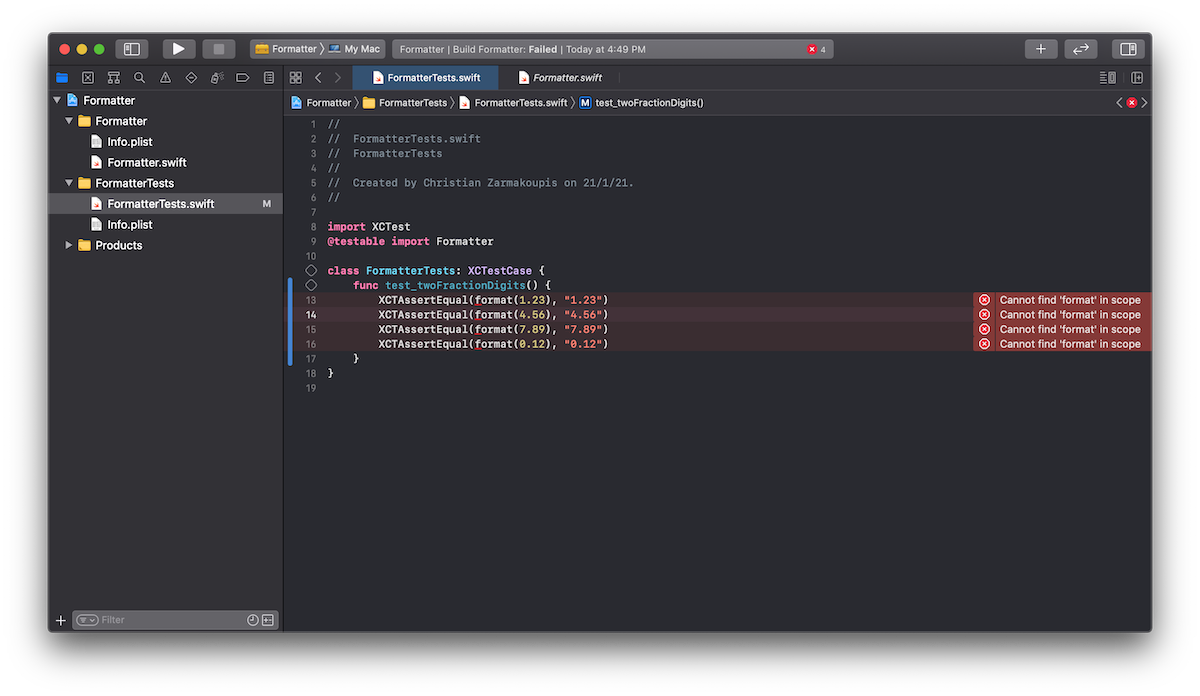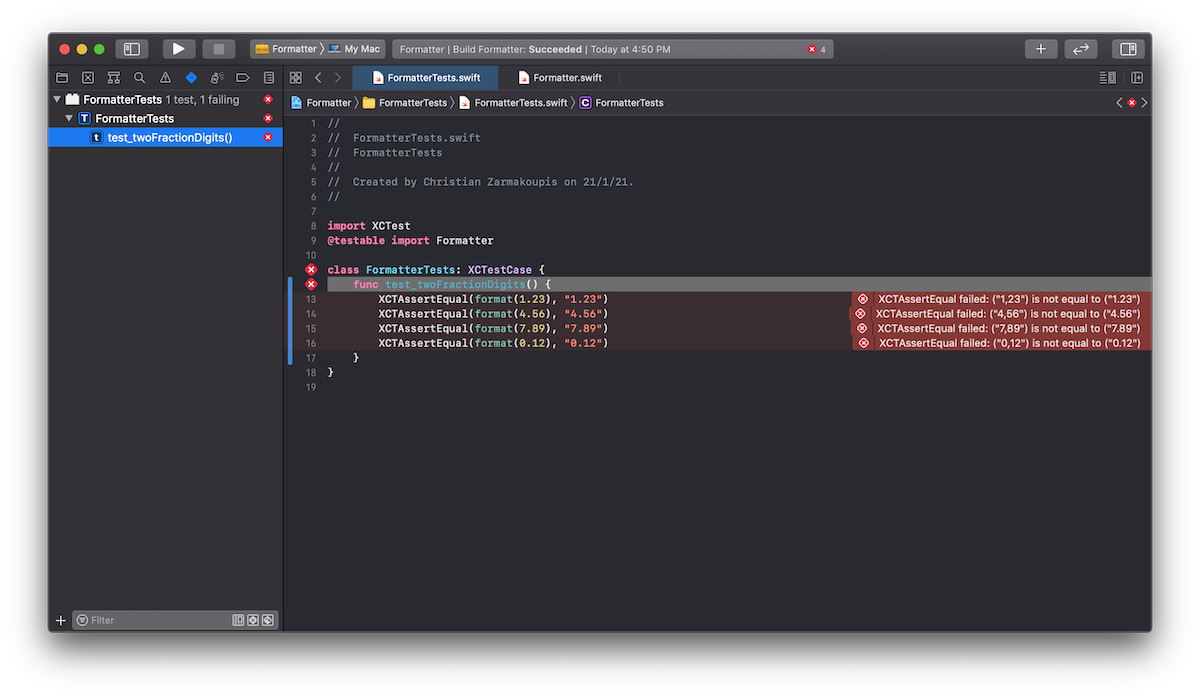How to create a custom Number Formatter using TDD
Presentation of the problem
While working on a project dealing with currency exchange rates I found myself in need of a custom formatter that would return string values following a particular set of rules.
For example, for the following inputs the rules expected the following outputs:
| Input | Output |
|---|---|
| 0.000032333 | “0.000032” |
| 14.00458 | “14.00” |
| 1.232 | “1.23” |
| 0.000032 | “0.000032” |
In this article, I documented how I approached this challenge by test-driving a custom formatter implementation. You can find the git repository here.
Solution of the problem
First step: Breaking down the requirements
First, I created a list of the rules and grouped possible scenarios that I wanted the formatter to handle.
So I ended up with these cases:
-
Returns string of number with two fraction digits for number with two fraction digits:
Input Output 1.23 “1.23” -
Returns string of number rounded to two fraction digits:
Input Output 14.00023 “14.00” 14.008 “14.01” 1.2342 “1.23” 1.230000 “1.23” -
Returns string of number rounded to two significant digits for values less than 1:
Input Output 0.000032 “0.000032” 0.0000323343 “0.000032” 0.0000328103 “0.000033” 0 “0.00”
Second step: The part of coding
After drafting the checklist I felt comfortable enough to start test-driving the formatter implementation.
The next step was to create a test assertion for each of the cases I mentioned above, by following the TDD cycle:
- Red state (we want to see a build fail and then a failing test)
- Green state (we want the test to pass with the minimum changes)
- Refactoring (refactor our code to be simple and easy to read if possible)
After writing the first test naturally there was a build error since there’s no production code yet.

The next step was to write the minimum code possible to make the project build again and pass the test.
func format(_ value: Decimal) -> String {
let nf = NumberFormatter()
nf.maximumFractionDigits = 2
return nf.string(from: value as NSNumber) ?? ""
}
However, the test didn’t pass as I initially expected. The problem was that I didn’t take into concideration the device’s locale which was different from the one used in the tests (the locale’s separator was “,” and the locale used in the tests was “.”). But that was good progress as I got to see the test failing.

So taking into consideration the devices locale I ended up with the following code:
import Foundation
func format(_ value: Decimal, locale: Locale) -> String {
let nf = NumberFormatter()
nf.maximumFractionDigits = 2
nf.locale = locale
return nf.string(from: value as NSNumber) ?? ""
}
@testable import Formatter
class FormatterTests: XCTestCase {
func test_twoFractionDigits() {
XCTAssertEqual(format(1.23, locale: Locale(identifier: "en_US")), "1.23")
XCTAssertEqual(format(4.56, locale: Locale(identifier: "en_US")), "4.56")
XCTAssertEqual(format(7.89, locale: Locale(identifier: "en_US")), "7.89")
XCTAssertEqual(format(0.12, locale: Locale(identifier: "en_US")), "0.12")
}
}
The test was finally green!

At this point there was nothing to refactor so I continued with the next tests following the same pattern for all the cases I had set.
The production code and tests now looked like this:
public final class Formatter {
public static func format(_ value: Decimal, locale: Locale) -> String {
let nf = NumberFormatter()
nf.maximumFractionDigits = 2
nf.minimumFractionDigits = 2
nf.locale = locale
if value < 1 {
nf.maximumSignificantDigits = 2
}
return nf.string(from: value as NSNumber) ?? ""
}
}
class FormatterTests: XCTestCase {
func test_twoFractionDigits() {
XCTAssertEqual(format(1.23), "1.23")
XCTAssertEqual(format(4.56), "4.56")
XCTAssertEqual(format(7.89), "7.89")
XCTAssertEqual(format(0.12), "0.12")
}
func test_roundsValuesToTwoFractionDigits() {
XCTAssertEqual(format(1.234), "1.23")
XCTAssertEqual(format(1.235), "1.24")
XCTAssertEqual(format(1.236), "1.24")
XCTAssertEqual(format(1.2300), "1.23")
XCTAssertEqual(format(1.00023), "1.00")
}
func test_roundsValuesToTwoSignificantDigitsWhenLessThanOne() {
XCTAssertEqual(format(0.000032), "0.000032")
XCTAssertEqual(format(0.0000323343), "0.000032")
XCTAssertEqual(format(0.0000328103), "0.000033")
XCTAssertEqual(format(0.0000325103), "0.000033")
}
// MARK: Helpers
func format(_ value: Decimal) -> String {
Formatter.format(value, locale: Locale(identifier: "en_US"))
}
}
But I wasn’t done yet. When testing functions that handle numbers I’ve found out that it’s always a good practice to triangulate cases and check if the rounding of the numbers works as you wish.
So I created another test case checking the rounding mode of the formatter.
func test_roundsHalfUpValuesToTwoFractionDigits() {
XCTAssertEqual(format(1.005), "1.01")
XCTAssertEqual(format(2.006), "2.01")
XCTAssertEqual(format(3.007), "3.01")
XCTAssertEqual(format(4.008), "4.01")
XCTAssertEqual(format(5.009), "5.01")
XCTAssertEqual(format(1.001), "1.00")
XCTAssertEqual(format(2.002), "2.00")
XCTAssertEqual(format(3.003), "3.00")
XCTAssertEqual(format(4.004), "4.00")
}
The test failed this time! The reason for that was that the implementation of Decimal input in the helper method of the tests works in the following way:
When passing a number as an input and declaring it as a Decimal what I’ve found out that happens is that Foundation handles it as a Double and then converts it into a Decimal. Because Decimals are more precise than Doubles you may not always get the expected Decimal representation.
For example, if the helper method’s input is 1.005 you end up testing the function for the value 1.004999999 and get a failing test.
To solve this issue, I changed the implementation of the helper method’s input to String literal to get the precision of the Decimal input I wanted to test. So the tests now look like this:
import XCTest
@testable import Formatter
class FormatterTests: XCTestCase {
func test_twoFractionDigits() {
XCTAssertEqual(format("1.23"), "1.23")
XCTAssertEqual(format("4.56"), "4.56")
XCTAssertEqual(format("7.89"), "7.89")
XCTAssertEqual(format("0.12"), "0.12")
}
func test_roundsValuesToTwoFractionDigits() {
XCTAssertEqual(format("1.234"), "1.23")
XCTAssertEqual(format("1.235"), "1.24")
XCTAssertEqual(format("1.236"), "1.24")
XCTAssertEqual(format("1.2300"), "1.23")
XCTAssertEqual(format("1.00023"), "1.00")
}
func test_roundsValuesToTwoSignificantDigitsWhenLessThanOne() {
XCTAssertEqual(format("0.000032"), "0.000032")
XCTAssertEqual(format("0.0000323343"), "0.000032")
XCTAssertEqual(format("0.0000328103"), "0.000033")
XCTAssertEqual(format("0.0000325103"), "0.000033")
}
func test_roundsHalfUpValuesToTwoFractionDigits() {
XCTAssertEqual(format("1.005"), "1.01")
XCTAssertEqual(format("2.006"), "2.01")
XCTAssertEqual(format("3.007"), "3.01")
XCTAssertEqual(format("4.008"), "4.01")
XCTAssertEqual(format("5.009"), "5.01")
XCTAssertEqual(format("1.001"), "1.00")
XCTAssertEqual(format("2.002"), "2.00")
XCTAssertEqual(format("3.003"), "3.00")
XCTAssertEqual(format("4.004"), "4.00")
}
// MARK: Helpers
func format(_ valueString: String) -> String {
guard let value = Decimal(string: valueString) else { return "" }
return Formatter.string(from: value, locale: Locale(identifier: "en_US"))
}
}
The test was now failing, however, by adding the following line in the Formatter makes it green:
nf.roundingMode = .halfUp
Summary
So in conclusion, creating a list with all the rules beforehand and grouping possible cases helped me test-drive the custom Formatter implementation and don’t get lost.
Another valuable takeaway is to provide the locale when creating custom formatters. By using the default locale you might end up with values that lead to wrongful assumptions, confusing user experiences, and flaky tests.
You can find this post’s repository on GitHub in the following here